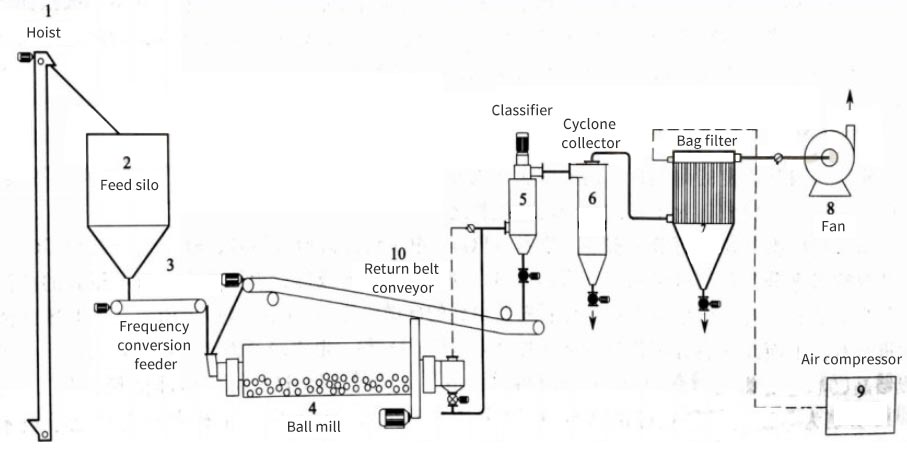Learn about general powder processing equipment production line

Powder processing equipment is an indispensable core component in modern industrial production. They run through multiple key process flows such as powder raw material transportation, grinding, classification, surface treatment, solid-solid separation, liquid-solid separation, gas-solid separation, drying, mixing, granulation, molding, roasting/calcining, cooling, packaging, and warehousing.
Feeding/Feeding: Vibrating feeder, Electromagnetic vibrating feeder, Screw feeder, Disc feeder, Rotary feeder
Conveying: Belt conveyor, Chain conveyor, Bucket elevator, Pneumatic conveyor, Hydraulic conveyor, Screw conveyor
Commonly used industrial powder and particle conveying equipment
1 Screw conveyor
2 Pipe chain conveyor
3 Positive pressure pneumatic conveying equipment
Grinding Mill
Jaw crusher: uses the movable jaw to periodically approach and leave the fixed jaw to crush materials.
Cone crusher: uses the swinging movable cone to periodically approach and leave the fixed cone to crush materials.
Hammer crusher: uses the impact generated by the rotation of the hammer head hinged on the rotor to crush materials.
Impact crusher: uses the impact of the plate hammer rigidly fixed on the rotor and the impact plate to crush materials.
Shear crusher: uses the relatively fast movement between the moving and static sharp blades to crush materials.
Roller mill: uses synchronously rotating extrusion rollers to crush materials.
Impact mill: uses horizontal high-speed rotating impellers to make materials move centrifugally at high speed, and collide and crush each other in the vortex chamber.
Ball mill/tube mill: uses the impact, grinding, and shearing of the grinding media in the rotating cylinder to crush materials. The grinding media are spherical, short columnar, rod-shaped, etc.
Screening mill: Use a mill with a screening mechanism to crush and classify the crushed materials.
Vibration mill: Use the impact, grinding and shearing of the grinding media in the vibrating cylinder to crush the material.
Tower mill/vertical stirred mill: Use the impact, grinding and shearing of the grinding media driven by the vertical stirring mechanism to crush the material.
Horizontal stirred mill: Use the impact, grinding and shearing of the grinding media driven by the horizontal stirring mechanism to crush the material.
Vertical mill/wheel mill: Use the relative rotation of the grinding disc and the grinding roller to grind and crush the material, and classify the ground material, such as Raymond mill, Loesche mill, etc.
Ring roller mill: Use the revolution and rotation of the grinding ring (roller) to crush the material between the grinding ring and the grinding circle by impact, collision, shearing.
Horizontal roller mill: The rotating cylinder forces the material to be clamped between the cylinder wall and the high-pressure roller, and is repeatedly squeezed, ground, sheared and crushed.
Planetary mill: Use the impact and grinding of the grinding media driven by the revolution and rotation of the grinding cylinder to crush the material.
Colloid mill: The material is sheared and ground between the high-speed rotating teeth and fixed teeth and is effectively emulsified and dispersed.
Airflow pulverizer: The material is crushed by strong collision, impact and friction between the materials or between the materials and the wall of the device using high-speed airflow.
Heavy-duty grinder: The disc-shaped roller runs along the bottom track, repeatedly applying rolling and shearing to crush the material.
Sidewall grinder: The cylindrical roller is driven by the rotating shaft to rotate and the side wall produces an extrusion effect to crush the material.
Classifying
Screening machine: Classification is performed using screens, including horizontal screens, vibrating screens, resonance screens, drum screens, etc.
Fixed screen: Classification is performed using an inclined screen plate composed of parallel grid bars.
Gravity sedimentation classifier: Classification is performed using the difference in the final settling speed of particles in the fluid.
Cyclone: Under the action of centrifugal force, larger particles are thrown to the wall of the device and rotate downward to be discharged, and smaller particles rotate upward to be discharged to achieve classification.
Centrifugal powder classifier: uses the different movement trajectories of particles in the centrifugal field to achieve gas-solid separation or powder classification.
Cyclone powder classifier: uses a turntable to drive the blades to rotate for powder classification.
Rotor classifier: When the gas-solid two-phase flow passes through the gap between the blades of the high-speed rotor, large particles are thrown out in the direction of centrifugal force, thereby classifying.
Dispersion classifier: The material is dispersed and scattered in the dispersion area and then enters the classification area.
